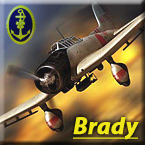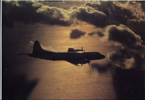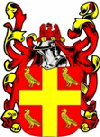Brady
Posts: 10701
Joined: 10/25/2002
From: Oregon,USA
Status: offline

|
Aircraft weapons designe and aplication in WW2 followed two diferent but equiley efective schools of thought. One focused on the idea of killing what was in the plane, the piolet or the engine. The Other was intent on Killing the plane.
1) Killing whats in the Plane: To acheave this weapons like the US .50 cal were employed largely just by Allied forces who were equpied with US equipment, and those equpied with the 20 mm Hispano. These weapons were large and Heavy and their ammo was heavy. They were efective killing tools, though as the war progreased most Enemy Aircraft including the Japanese had Armor in vital areas that was capable of defeating the .50 cal. These weapons fired High velocity rounds whose ammo chanin compasation was largely AP, the intent was to blugen their way into the aircraft and Kill the engine and the piolet.
2) Killing the plane. Prety much every other combantant in WW2, Japan, Germay, Russia, Italy, adopted this method, which focused on firing Largely HEI rounds at reasionable velocitys, optimised for efecive shoting ranges in the 400 meter range or lower. Studies indicated that prety much all combat took place withen this range*. So waht we see in the wepaons field by these countries are for the most part Light compact and very efficient weapons with High rates of fire, and whos ammo chain compasation was largely HEI in compasation, Japanese Ammo chanis were 4 HEI 1 APT in make up, German chains Varied but tended to have more AP rouinds depending on the gun, MK 103's were prety much all HEI, MG 151 tended to fire more of a mix. Italian Guns tended to be the worst preforming of the lot, while Some Russian Guns possed stagering ROF's. These weapons and their ammo were largely talyored at defeating the plane, that is blowing it apart.
Some Quotes from Tony Williams excelent book, Flying Guns WW II, ISBN 1 84037 227 3:
p.149:
"Overall the USN and the USAAF stand out for their adhearance to the .50 cal, even when the airforces of all other nations adopted 20mm or even 30mm cannon as aramament, at least for fighter aircraft. This has led some to conclude that if the USAAF and the USN prefered the .50 browning, this must of been the best weapon available, better than the 20mm cannon. This view has resulted in claims of extreamly high preformance for this weapon, somtimes far beyond the reasionable. It was also common to underestimate the preformance of other nations weapons."
"(ref 50 cal), it's high MV and gave it a long effective range, good armor penatration, and excelent accuracery, but a penatility was paid in the form of relaively high weight and barrel wear and a modest rate of fire. In 1940 modifications were made to increase the RoF from 400-600 rpm to 750-800, but this remained run of the mill by wartime standards: rates of fire for HMGs varied between 700 and 1,050 rpm"
"Even at 800 rpm barrel wear was a sevear problem, piolets and gunners were instructed to fire short bursts...a gun could fire a burst of 75 rounds without damage, but after that a gun was restricted to 25 round bursts....this problem was not solved untill January 44"
"The US Navy concluded that a single 20mm Hispano was the equilvent to three .50 guns, the 20mm also had better Armor penatration and did not suffer so much from over heating"
"At the end of the war some German and Japanese aircraft carried armor that was fairely effective aganst the 12.7mm projectiles. In some aircraft the USN and the USAAF did use the 20mm Hispano AN-M2, but although crews appricated the greater destructive power of the larger gun, they complained about it's reliabality."
* This is whear the Weight of the US .50 cal weapons becomes a mark aganst then, while efecive and capable of firing to ranges acuraterly well beyond 400, it was largely usless, since as noted above and readly refrenced, combat just realy dident hapen at longer ranges.
So as we can see from above when considering the the 50 call Browing as a n aircraft weapon when compared to it's contempoarys, it is very heavy by comparasion, a very undersiable carasteric in a aircraft gun, it has what at the time would be considered a lower RoF for when compared to it's contempoarys, and it was operating under sever firing restrictions for a big part of the war, and then later in the war had it's effectiveness decreased by the aplication of better armor on enemy planes designed to defeat it. The single bigest reasion it was used to the extent it was had more to do with this:
"The real advatages of the .50 were in it's great reliabality and it's standaradisation....the use of a single type of gun greatly eased suply and traing problems..."
Than it realy being a great aircraft weapon, their are many other WW2 aircraft weapons that would be considered "better" over all.
After WW2 in Korea for example, US planes9with 50 call guns) were commonly considered underguned when compared to Soviet fighters.
"When the USA entered the war it had fallen behind in the development of arament for combat aircraft, because very limited resources had been available between the wars, it already had howeaver a very good heavy machine gun in the Browing .50 cal M2,....The intruduction of more powerfull or more modern weapons remained limited to a relatively small number of aircraft..."
Now some Quotes detaling the efect's of HE and HEI type ammo:
p. 40 Flying Guns:
"The Luftwaffe discovered that AP amunation was not ushually as effective as HE, partialy because the armored parts of an aircraft were small and not often hit, partly because of eratic of the eratic preformance of AP described in the nexct section. It was discovered that to be more productive to maximise the HEI content to inflict balst damage on the aircrafts structure......Starting in the late 1930's Germany developed the minegeschloss."
" The German aproach represented a compleatly different philosophy from that of the USAAF. Instead of using the kinetic engery of large numbers of high velocity AP Bullets to destroy the target, the luftwaffe relied on blast effect of large quantities of HE detonating withen the structure. Both aproaches seemed to work well"
" The 30mm HEI M-Geschoss, fired from a MK 108, was tested on a Spitfire fusalage, of 10 rounds fired 3 resulted in a score of imeadately lethal, seven probably lethal"
" The Germans discovered that a wing hit on a B-17 resulted in a whole 100 x 175 cm. It was noted that the ammunation did not have much effect on heavy bomber fuslages (presumably becuase of the larger volume for the explosion to disapate into), but inflicted serious aerodynamic damage to the wings by blowing off the surfaces, and that the incendary content was very effective in starting fires."
"German tests reflected these results, and also reveiled signafagant diferances in the efect of mine shels on depending on the construction of the aircraft. Stresedskin aloy monocore structures were the most vulnerable to being blow apart. Steal structures clad with thin aluminium were less affected as the cladding quickly split, relessing preshure before it had much time to damage the structure, and fabric covered structures, such as the wellington bomber, were damaged least of all. It was not only the blast which inflicted the damage; after the war the Americans test fired a MK 108 shel into the tail of a B-24 at a typical angle, caracteristic of a tail interception by a 262. The Spray patern of very heigh velocity, very small fraements, cut most most if not all of the controle cables and many longerons. It was assesed that the tail would have seperated if the plane had been in flight."
" Japanese cannon projectiles varried between the heavy (IJN 20mm Type 99 projectiles weighed around 128 g, the IJA's Ho-1 and Ho-3 up to around 127-136 g) to the very light (IJA 20mm Ho-5 as little as 79 g). AP Projectiles were cannon type ( i.e. solid steal) rather than using subcaliber cores. HE shels generaly had a modest filling ratio, although the little 79 g Ma 202 HEI used in the Ho-5 managed an impresive- for a non M-Geschoss- fifteen percent charge weight ratio."
"The actual preformance of AP projectiles in battle can vary considerably from that acheaved on test. In particular, passing through the thin aluminum aircraft skin can induce yaw, i.e. disturb the streight flight of the projectile away from traveling point to first, so that it fails to hit the armor head on, theryby significantly reducing it's penetrative abailitys. In fact the degrees of obstruction caused by aircraft structures is such that armor much thiner than therory indicated nescessary was often found to give satasifactory results."
The weight and the HEI content of Japanese Type 99 (MK I and II used the same projectile) resulted in a letality comperable with that of the Hispano.
.................
Ok SO whats all this about anyway? Well....
When you look at the data base for WiTP and start to compare how the Guns are rated in the game you will see some Interesting figures like:
Device # 161-0.5in Browning MG:
Range 4
Penatration 2
Accuracery 29
Efect 3
Device # 168-20mm Hispano Cannon
Range 5
Penatration 3
Accuracery 26
Efect 4
...........
Device # 191 20mm Ho-5
Range 5
Accuracy 28
Effect 4
Penatration 3
Device # 188 20mm Type 99 Cannon
Range 5
Accuracery 22
Efect 4
Penatration 3
Device # 189 20 mm Type 99 MK II
Range 5
Accuracery 23
Efect 4
Penatration 3
..............
The Big Problem here* is the relative values of the Weapons, The Cannos are only slightly more efective than the .50 cal, they should be at least twice as efective, acording to Tony the Hispano and the Type 99 should be Three times as efective, presonaly I feal the Ho-5 should be twice as efectve not Three thimes as a .50 cal. in game terms. This is why their is a pro allied slant, not that I for a sec. beelave it is intentional but the end result is the same as if it were.
As noted on another thread, the Second Bigest determiner in A to A resulation is the Gun Values of the planes, while Japanese Planes should be as efective if not more in terms of lethality (depening on plane type and gun package) they are on average 30 to 50% less lethal than they should be vs their aponets.
* or is it hear Mogami?
..............
O- The Type (( MK II should be a tad more acurate, their should be a bigher distinction between the MK and the II, Say a 24 for the MK II, accuracery wise.
< Message edited by Brady -- 9/10/2005 7:43:37 PM >
_____________________________
Beta Team Member for: WPO PC CF AE WiTE Obi-wan Kenobi said it best: A lot of the reality we perceive depend on our point of view
|
 Printable Version
Printable Version










 However, these were opinions given by people who used the weapons, so some weight should be given to them. These opinions were based on real-life experience, not from what SHOULD be based on results from a test range comparison.
However, these were opinions given by people who used the weapons, so some weight should be given to them. These opinions were based on real-life experience, not from what SHOULD be based on results from a test range comparison. 






 New Messages
New Messages No New Messages
No New Messages Hot Topic w/ New Messages
Hot Topic w/ New Messages Hot Topic w/o New Messages
Hot Topic w/o New Messages Locked w/ New Messages
Locked w/ New Messages Locked w/o New Messages
Locked w/o New Messages Post New Thread
Post New Thread